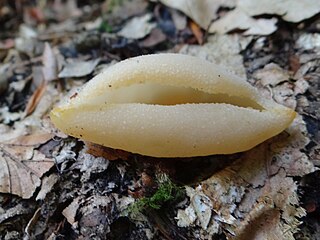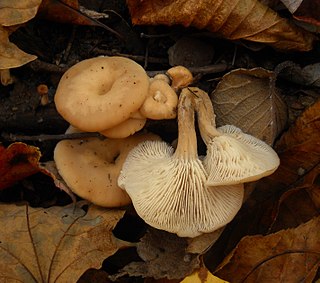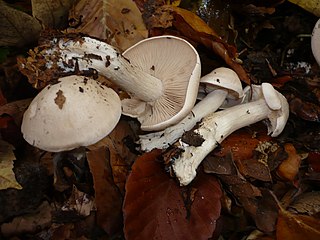
Artomyces pyxidatus is a coral fungus that is commonly called crown coral or crown-tipped coral fungus. Its most characteristic feature is the crown-like shape of the tips of its branches. The epithet pyxidatus means "box-like"—a reference to this shape.

Pleurotus ostreatus, the oyster mushroom, oyster fungus, hiratake, or pearl oyster mushroom is a common edible mushroom. It is one of the more commonly sought wild mushrooms, though it can also be cultivated on straw and other media.

The foxface rabbitfish, also known as the foxface, black-face rabbit fish, badger fish or the common foxface is a species of marine ray-finned fish, a rabbitfish belonging to the family Siganidae. It is found in the Indian and Pacific Oceans. It can be found in the aquarium trade.

Pantherophis vulpinus, commonly known as the foxsnake or the eastern fox snake, is a species of nonvenomous rat snake in the family Colubridae. The species is native to North America.

Amanita citrina, commonly known as the false death cap or citron amanita, is a basidiomycotic mushroom, one of many in the genus Amanita. It grows in silicate soil in the summer and autumn months. It bears a pale yellow or sometimes white cap, with white stem, ring and volva. It is an inedible mushroom due to its toxicity, but is more pertinently often confused for the lethal death cap.

The common thresher, also known as Atlantic thresher, is the largest species of thresher shark, family Alopiidae, reaching some 6 m (20 ft) in length. About half of its length consists of the elongated upper lobe of its caudal fin. With a streamlined body, short pointed snout, and modestly sized eyes, the common thresher resembles the pelagic thresher. It can be distinguished from the latter species by the white of its belly extending in a band over the bases of its pectoral fins. The common thresher is distributed worldwide in tropical and temperate waters, though it prefers cooler temperatures. It can be found both close to shore and in the open ocean, from the surface to a depth of 550 m (1,800 ft). It is seasonally migratory and spends summers at lower latitudes.

Orson Knapp Miller Jr. was an American mycologist. He published numerous papers in mycology and was responsible for the naming of many taxa, as well as being one of the authors erecting the genus Chroogomphus. He described Omphalotus olivascens, several species of Amanita, and the ghoul fungus Hebeloma aminophilum.

Lentinellus is a genus of white rot, wood decay, lamellate agaric in the family Auriscalpiaceae, further characterized in part by rough-walled, amyloid spores produced on lamellae with jagged edges. Typically, thick-walled hyphae in the fruit body are in part amyloid, and frequently the taste of the mushrooms is acrid. The widespread genus has been estimated to contain 15 species. Mycologists Ronald Petersen and Karen Hughes considered 24 species in their 2004 world monograph of the genus.

Lentinellus cochleatus, commonly known as the aniseed cockleshell, is a wood-inhabiting fungus. It has a mild aniseed odor and flavor. Like all species in its genus, it is inedible due to its bitterness.

Agrocybe pediades, commonly known as the common fieldcap or common agrocybe, is a typically lawn and other types of grassland mushroom, but can also grow on mulch containing horse manure. It was first described as Agaricus pediades by Swedish mycologist Elias Magnus Fries in 1821, and moved to its current genus Agrocybe by Victor Fayod in 1889. A synonym for this mushroom is Agrocybe semiorbicularis, though some guides list these separately. Technically it is edible, but it could be confused with poisonous species, including one of the genus Hebeloma.
Lycoperdon radicatum is a species of puffball mushroom, also called rooting puffball, in the family Agaricaceae. It was described in 1848 by French botanists Michel Charles Durieu de Maisonneuve and Camille Montagne in Algeria. Due to its Bovista-like capillitium it was previously placed in the genus Bovistella. It is nonpoisonous. It is easily recognised by its 4-8 cm rigid, white-gray pseudoroot.

Phyllotopsis nidulans, commonly known as the mock oyster or the orange oyster, is a species of fungus in the family Phyllotopsidaceae, and the type species of the genus Phyllotopsis. It is widely dispersed in temperate zones of the Northern Hemisphere, where it grows on decaying wood. The fungus fruit body consists of a fan-shaped, light orange fuzzy cap up to 8 cm (3 in) wide that grows singly or in overlapping clusters. On the cap underside are crowded orange gills. Mock oyster mushrooms have a strong, unpleasant odor, and are regarded as inedible though nonpoisonous.

Tarzetta catinus is a species of apothecial fungus belonging to the family Pyronemataceae. This is a largely European species with a few records from Mexico and the United States. It appears from spring to autumn as cream-coloured cups up to 5 cm across, usually in small groups among broad-leaved trees, especially beech. The rather similar Tarzetta cupularis is usually a smaller, deeper, flask-shaped cup, but the two species can only be reliably distinguished microscopically: by the shape of the spores and the paraphyses.

Amanita volvata, also known as volvate amanita is an inedible white-coloured species of fungi from the family Amanitaceae found in the southeastern United States. Can be confused with Amanita ponderosa, but that species is from the Iberian peninsula. The species is amyloid and have saccate volva, and elliptic spores.

Lentinellus montanus is a species of agaric fungus in the family Auriscalpiaceae. It is found at high elevations in the Pacific Northwest region of North America, where it fruits singly or in clumps on decaying conifer wood.

Amanita excelsa, also known as the European false blushing amanita, is a species of agaric fungus in the family Amanitaceae. It is found in Asia, Europe, and North America, where it grows in deciduous forests.

Lentinellus micheneri is a species of wood-inhabiting fungus in the family Auriscalpiaceae. It was first described in 1853 by mycologist Miles Berkeley and Moses Ashley Curtis as Lentinus micheneri. David Pegler transferred it to the genus Lentinellus in 1983. Like all species in its genus, it is inedible.

Amanita mutabilis is a species of Amanita from eastern United States. Amanita mutabilis has pink tones on the cap and stem, and will turn pink when its flesh is cut; it smells of anise.

Lepista irina is a species of fungus belonging to the family Tricholomataceae. It is a choice edible mushroom.

Lentinellus ursinus is a species of fungus belonging to the family Auriscalpiaceae. Like all species in its genus, it is inedible due to its bitterness.


















